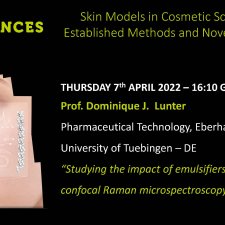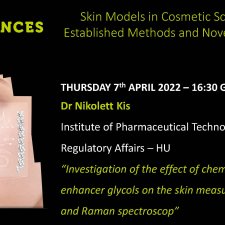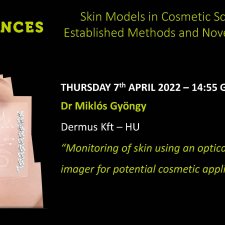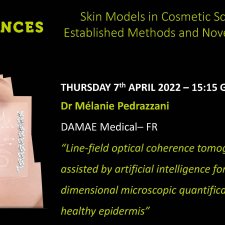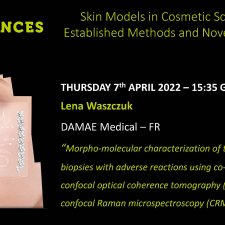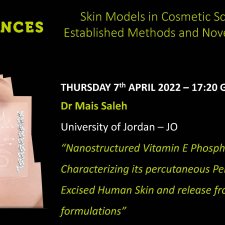Notice
Michal Szczepanczyk - Catalase activity in keratinocytes, stratum corneum, and defatted algae biomass as a potential skin care ingredient
- document 1 document 2 document 3
- niveau 1 niveau 2 niveau 3
Descriptif
Catalase is one of the most important antioxidative enzymes. Its main function is the decomposition of hydrogen peroxide belonging to the group of reactive oxygen species. Disbalance in hydrogen peroxide metabolism in the skin associated with reduced catalase expression can result in the development of skin diseases, such as vitiligo, polymorphic light eruption, and xeroderma pigmentosum. For some of these conditions, the topical application of exogenous catalases was suggested to support the natural antioxidative system. The purpose of our work was to develop an in vitro method allowing for the investigation of H2O2 decomposition at controlled conditions where the antioxidative enzyme is residing in a realistic biological matrix and to assess the catalase activity and the apparent kinetics of catalase in keratinocytes and stratum corneum (SC) samples and to make a comparison with the corresponding catalase function in defatted algae biomass (DAB), which may serve as a potential source of catalase and other antioxidative enzymes or metabolites to be used in skin care applications.
Catalases are the only group of enzymes able to generate gaseous oxygen therefore measurements of enzyme activity were based on the Clark oxygen electrode, which was employed to determine the concentration of oxygen produced by the catalase in various biological samples related to the skin organ or potential green sources of catalase to be used as a skin care ingredient.
In conclusion, the results of our work illustrate the advantages of the simple and highly available oxygen electrode method, such as its versatility and ability to provide fast and accurate measurements with small sample amounts of various biological samples of varying complexity, such as keratinocytes, excised SC, and DAB. By using this method, we demonstrated that DAB, a byproduct from food supplement manufacturing, retains quantifiable and hopefully valuable catalase activity after oil extraction and prolonged storage time.
Thème
Dans la même collection
-
Dr Julien Chlasta - How’s AFM a fantastic tool in cosmetic research?
Atomic force microscopy (AFM) is a tool for nanoscale analysis-based approach allowing to obtain mechanical information about structures
-
Dr Catherine Grillon - New reconstructed epidermis models closer to skin physiology
Among skin models, reconstructed human epidermis are largely used in cosmetic domain either to evaluate compounds activity or for regulatory tests such as toxicity. They represent a good alternative
-
Dr Franciska Erdo - Studying topical drug delivery in Skin-on-a-chip and by Confocal RAMAN spectros…
Studying skin composition and interaction with topical substances is important both in dermatology and cosmetoscience. Several techniques are utilized and are under development for these purposes.
-
Marek Puskar - Evaluation of serum growth factors in wound healing using a full-thickness in vitro …
Following skin injury, damaged tissue undergoes highly coordinated biological events to restore barrier function involving cross-talk between dermal fibroblasts and epidermal keratinocytes as well as
-
Prof. Dominique J. Lunter - Studying the impact of emulsifiers on SC lipids by confocal Raman micr…
Emulsifiers are widely used in face washes, shower gels, body lotions and many more cosmetic and pharmaceutic products. Some of them are suspected to show irritating effects and to harm the skin
-
Dr Maxim Darvin - Two-photon excited fluorescence lifetime imaging for non-invasive visualization …
Mast cells (MCs) and macrophages (ΜΦs) are important multifunctional immune cells found in all tissues of the body. In the skin, resting and activated MC populations and M1- and M2-polarized ΜΦs are
-
Dr Nikolett Kis - Investigation of the effect of chemical permeation enhancer glycols on the skin m…
Dermal drug delivery is an attractive alternative to conventional drug administration due to its advantages.
-
Dr Miklós Gyöngy - Monitoring of skin using an optical-ultrasound imager for potential cosmetic app…
Optical-ultrasound imaging is a cost-effective method of simultaneously imaging the skin surface and the region under the surface.
-
Dr Mélanie Pedrazzani - Line-field optical coherence tomography (LC-OCT) assisted by artificial int…
Line-field confocal optical coherence tomography (LC-OCT) is an optical technique based on a combination of confocal microscopy and optical coherence tomography, allowing three-dimensional (3D)
-
Lena Waszczuk - Morpho-molecular characterization of tattooed skin biopsies with adverse reactions …
Line-field confocal optical coherence tomography (LC-OCT) is a non-invasive optical technique for imaging the skin at high resolution (∼ 1 μm), based on a combination of OCT and reflectance confocal
-
Dr Mais Saleh - Nanostructured Vitamin E Phosphate: Characterizing its percutaneous Penetration int…
Modern topical sunscreens combine topical antioxidants with physical UV filters to achieve optimal skin protection1–3. α-Tocopherol phosphate (α-TP), a new pro-vitamin E antioxidant, prevents UVA1
-
Dr Jeyaraj Ponmozhi - Realtime analysis of drug (diffusion, toxicity, would healing, repair, inflam…
Advantages of microfluidics could outnumber the advantages in reconstructed and excised skin samples in certain cases for the study on permeability, toxicity, irritation, corrosion, disease models





